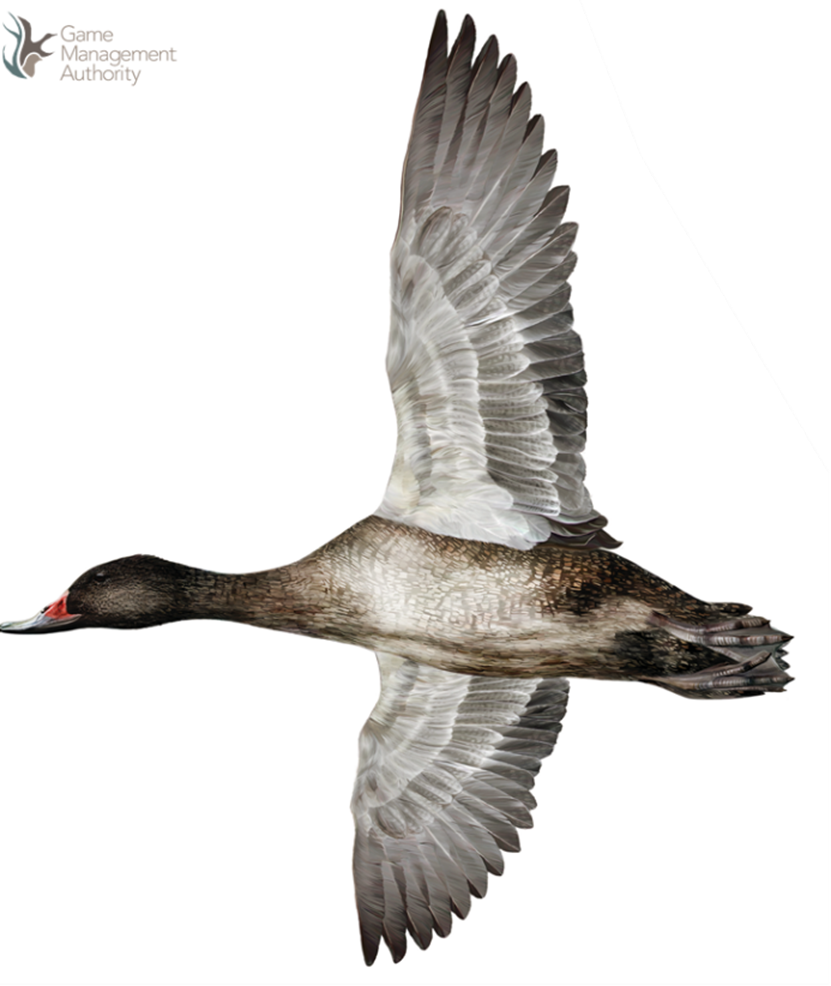Duck season arrangements
The Victorian Government announced the following arrangements for the 2025 duck hunting season:
Season length
Season open – 8.00am on 19 March 2025
Season closes – 30 minutes after sunset on Monday, 9 June 2025
Bag limit
Daily bag limit of nine (9) game ducks per day for the 2025 season.
Start and finish times
The hunting start time is 8:00am until 30 minutes after sunset for the first five days (19-23 March, inclusive), then from 30 minutes before sunrise until 30 minutes after sunset for the remainder of the season.
Game duck species permitted to be taken
Seven game duck species are permitted to be hunted during the 2025 season. Species permitted are Pacific Black Duck, Mountain Duck, Chestnut Teal, Grey Teal, Pink-eared Duck, Wood Duck and Hardhead.
The Blue-winged Shoveler cannot be hunted.
Retrieval of downed game ducks
Regulations require hunters to make all reasonable efforts to immediately retrieve all downed game ducks and to salvage at least the breast meat from all harvested ducks.
Other arrangements
Only non-toxic shot can be used to hunt ducks anywhere in Victoria. Lead is not permitted.
The Wildlife (Game) Regulations were remade in September 2024 and resulted in some changes to how duck hunting occurs in Victoria. Changes include:
- The season opens on the third Wednesday in March each year (mid-week opening)
- The hunting start time for the first five days of each season is 8:00am
- Changing the hours that non-authorised people are prevented from entering specified hunting areas to 11am for the first five days of the duck season
- Two new gundog breeds may be used for duck hunting, including Wirehaired Slovakian Pointer and Murray River Retriever
- Blue-winged Shoveler has a year-round close season and may not be hunted
- Exemptions allowing the use of lead shot for duck hunting in Damascus and twist-barrelled shotguns have been removed. Lead shot must not be used for duck hunting in Victoria.
For more information on the new Wildlife (Game) Regulations 2024, please visit the DJSIR website at Game Hunting | Department of Jobs, Skills, Industry and Regions:
Hunters are reminded to review our education material to ensure accurate identification of waterfowl, humane dispatch methods and responsible hunting techniques.
Please monitor the GMA website before and during the season to see if wetlands have been closed to hunting or hunting has been further regulated.
Hunters are reminded to hunt responsibly at all times.
Fact Sheet – No hunting of Blue-winged Shoveler
Blue-winged Shoveler (Spatula rhynchotis) cannot be hunted during the duck season in Victoria. In 2021, the species was listed as threatened under the Flora and Fauna Guarantee Act 1988 and the Wildlife (Game) Regulations in 2024 introduced a year-round close season. The information below will remind you of the key distinguishing features to look out for in the Blue-winged Shoveler.
Importantly, if you are NOT SURE, DON’T SHOOT. The penalties for illegally shooting protected species could include a substantial fine, imprisonment or both.
Appearance
The Blue-winged Shoveler is a distinctive species with a slender build and broad, blue-grey bill. Male and female Shovelers have different plumage, with the male being more colourful than the female.
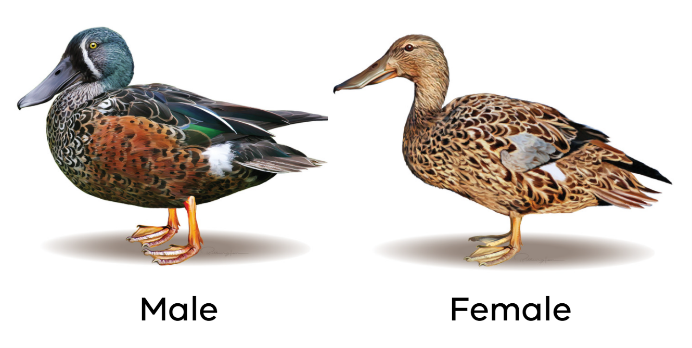
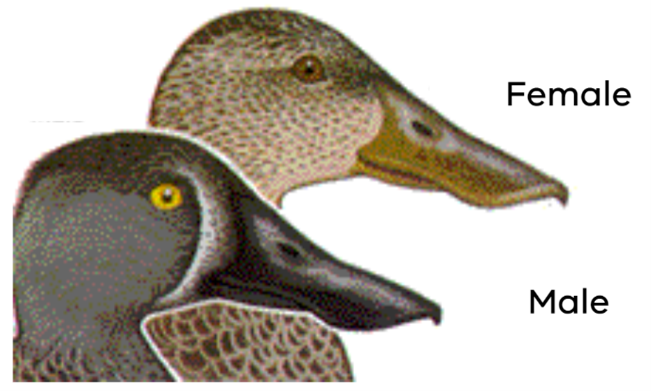 When in breeding condition, the male has a shiny blue-green head, white face crescent in front of a yellow eye, black back, blue patch on the upperwing, a distinct white patch on the rump and deep chestnut-coloured flanks and belly. Outside the breeding season, this colouring fades and becomes dull. The male also has bright yellow/orange legs and is the only native duck to do so.
When in breeding condition, the male has a shiny blue-green head, white face crescent in front of a yellow eye, black back, blue patch on the upperwing, a distinct white patch on the rump and deep chestnut-coloured flanks and belly. Outside the breeding season, this colouring fades and becomes dull. The male also has bright yellow/orange legs and is the only native duck to do so.
The female Shoveler lacks the bright colouring of the male and is predominantly brown with a fawn-coloured belly. Females also have the blue patch on the upperwing. They also have yellow/orange legs, which may be more drab in colour than the males. Immature birds resemble females.
In flight
The Blue-winged Shoveler flies quickly, erratically and often in tight formation when flying in a flock.
It has very quick wing beats with a distinctive whirring sound. In good light, the upper wing patch is obvious in both males and females and is fringed with white. Beneath the wing, the front feathers are white and clearly contrast with its darker rear feathers and belly.
The Blue-winged Shoveler has a distinct profile with a relatively short tail and long bill and head, which gives it a front heavy appearance. At relatively close range, you can clearly see the distinctive wedge-shaped bill of the Shoveler.
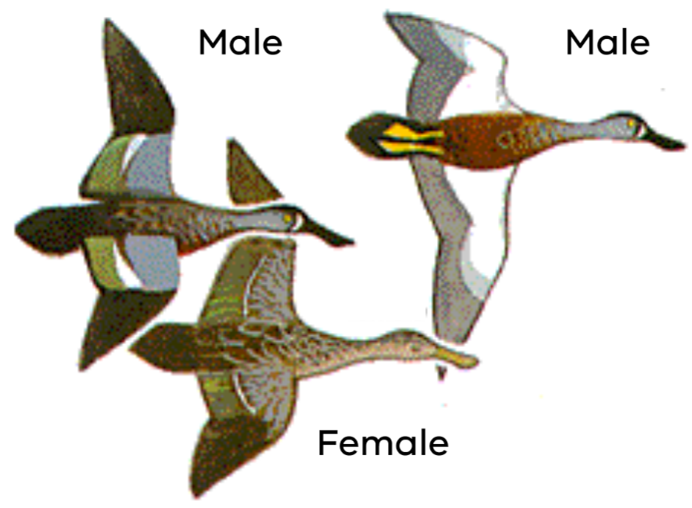
On the water
On the water, the Blue-winged Shoveler is a medium-sized duck which floats low. The large shovel-shaped bill, which gives the bird its name, finishes flush with the top of its head making it wedge-shaped in appearance. The male also has a white patch on its rump.

Habitat and distribution
The Blue-winged Shoveler is an uncommon duck which is distributed throughout south-eastern and south-western Australia.
Shovelers prefer permanent, well-vegetated freshwater or saline wetlands with areas of open water and are usually found in inland cumbungi swamps and coastal tea-tree swamps.
Blue-winged Shovelers are seldom heard but do have a soft chatter when flying.
To see high definition video footage of the Blue-winged Shoveler and other waterfowl species, visit the GMA website and go to the Education section to find the DuckWISE education videos, or visit: gma.vic.gov.au/education/duck-hunting-education/duck-wise-education-video
Tips for identifying Blue-winged Shoveler
- Quick and erratic flight
- Large shovel-shaped bill
- Blue patch on upper wing
- White underwing
- Yellow/orange legs
- Male has a yellow eye
- Found in well vegetated freshwater or saline swamp.
Penalties
The Blue-winged Shoveler is listed as a threatened species under Victoria’s Flora and Fauna Guarantee Act 1988. It is a serious offence to hunt, take or destroy threatened wildlife under the Wildlife Act 1975.
The penalty for doing so is a fine up to the value of 240 penalty units or 24 months imprisonment, or both. Remember, if you are not sure, don’t shoot.
Hunting on private and public land
Game laws apply to both private and public land. Authorised Officers and Victoria Police will enforce the game laws on all land classifications.
Report illegal hunting
To report illegal hunting, visit gma.vic.gov.au and complete the online form or call 136 186.
Hunters and members of the community are urged to report illegal hunting to the GMA. People breaching game hunting or public safety laws may face significant fines and penalties, including court prosecution and criminal conviction.
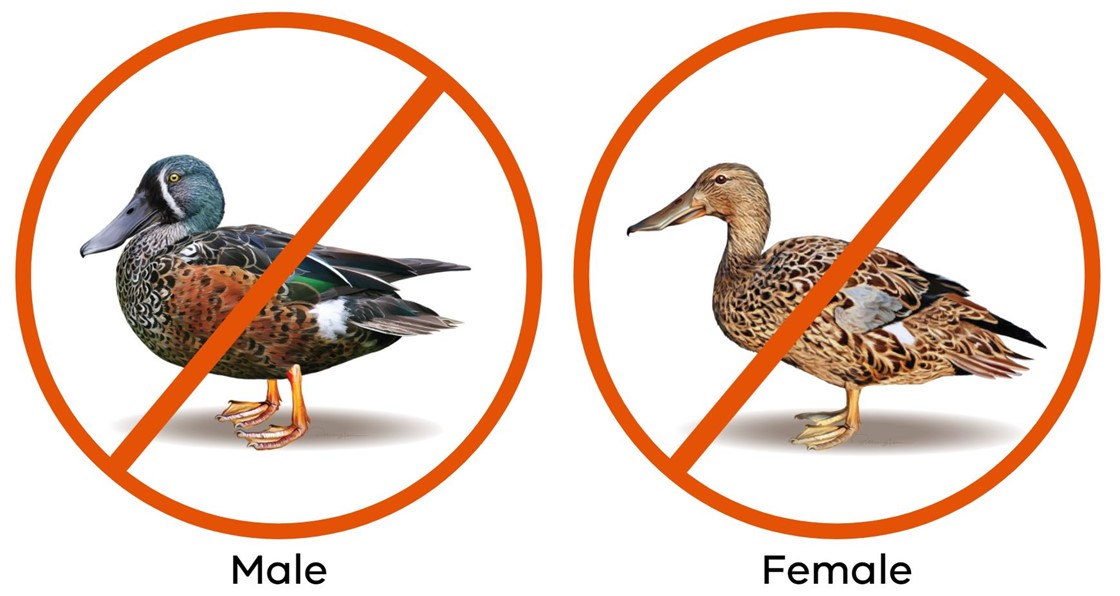
Fact sheet - Freckled Duck – Not sure, don’t shoot
In Victoria, the Freckled Duck is declared a threatened species and must not be hunted. While not a common sight, hunters may encounter Freckled Duck, particularly in times of drought. Freckled Duck should never be confused with Victoria’s game duck species.
The following information will help hunters to identify Freckled Duck. Importantly, if you are NOT SURE, DON’T SHOOT, otherwise you could be facing a substantial fine, imprisonment or both.
Description
The Freckled Duck (Stictonetta naevosa) is a medium- sized duck, similar in size to a Pacific Black Duck. They are heavy bodied and dark grey/brown in colour.
The whole body is speckled with off-white markings which are visible up close. However, don’t rely on this freckled pattern to identify a bird in flight. From a distance, the bird appears a uniform grey/brown.
The bill of the Freckled Duck is a distinctive, narrow, up-turned shape (dished with a heavy base) which, in breeding males, has a bright red base. On the water, the Freckled Duck has a tuft of feathers sticking out at the back of its head. This tuft of feathers and up-turned bill make it easy to identify the Freckled Duck on the water.
Freckled Duck has no distinctive markings on its upper wing. The female plumage is similar to the male but is generally lighter in colour.
In flight, the Freckled Duck appears as a uniform grey/brown colour with the underwings and belly appearing paler than the rest of its plumage. It typically flies with a head down or hunched appearance.
In flight and on the water, the Freckled Duck will often mix with game duck species. Hunters need to be careful and able to identify the birds they are hunting.
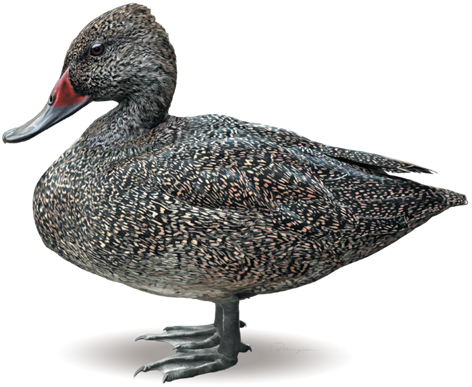
Distribution
Freckled Duck are found mainly in south-eastern and south-western Australia and inland along the Diamantina River and Coopers Creek.
In Victoria, Freckled Duck have been recorded mainly from wetlands throughout the northern, western and Gippsland areas. They most commonly appear during times of drought when they seek refuge on Victorian waters.
Habitat
Freckled Duck have been recorded on permanent, open freshwater, deep freshwater marshes and saline wetlands in Victoria.
Permanent swamps or freshly flooded creeks containing cumbungi and tangled lignum are favoured inland breeding habitat, while in coastal districts, the densest tea-tree swamps are most favoured for breeding.
Freckled Duck use different wetlands under different conditions. During dry periods or under drought conditions, Freckled Duck are forced from non-permanent breeding swamps and occupy large permanent open waters, particularly lakes and reservoirs larger than 100 hectares. In wet years, they are largely sedentary.
Tips for identifying Freckled Duck
For Freckled Ducks in flight, look for:
- Head down or hunched appearance
- Uniform dark brown to dark grey colour
- No distinct markings on the upper wing
- A lighter plumage colour on belly and narrow white triangle close to body on underwing.
For Freckled Ducks on the water, look for:
- Dark brown/grey plumage speckled with off-white markings
- An up-turned (‘dished’) bill
- Red colour at the base of the bill in breeding males
- A tuft of feathers sticking out the back of the head.
Penalties
The Freckled Duck is listed as a threatened species under Victoria’s Flora and Fauna Guarantee Act 1988. It is a serious offence to hunt, take or destroy threatened wildlife under the Wildlife Act 1975.
The penalty for doing so is a fine up to the value of 240 penalty units or 24 months imprisonment, or both. If you are NOT SURE, DON’T SHOOT.
Hunting on private and public land
Game laws apply to both private and public land. Authorised Officers and Victoria Police will enforce the game laws on all land classifications.
Report illegal hunting
To report illegal hunting, visit gma.vic.gov.au and complete the online form or call 136 186.
Hunters and members of the community are urged to report illegal hunting to the GMA. People breaching game hunting or public safety laws may face significant fines and penalties, including court prosecution and criminal conviction.
